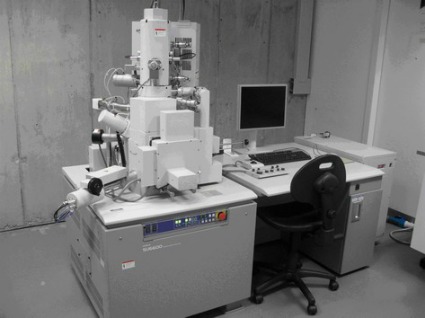FOCAS Institute SEM Request Form
Overview:
The scanning electron microscope (SEM) is a type of electron microscope that images the sample surface by scanning it with a high-energy beam of electrons in a raster scan pattern. The electrons interact with the shells in atoms that make up the sample producing signals that contain information about the sample's surface topography, composition and other properties such as electrical conductivity.

The types of signals produced by an SEM include secondary electrons (SE), back-scattered electrons (BSE), characteristic X-rays, light (cathodoluminescence), specimen current and transmitted electrons (STEM). Generally the most common or standard detection mode is SE imaging. The spot size in a Field Emission SEM is smaller than in conventional SEM and can therefore produce very high-resolution images, revealing details in the range of 1 to 5 nm in size.
The SU 6600 is a variable pressure FESEM with a Schottky field emission electron gun which enables excess of 200nA probe current. The SU 6600 at the FOCAS Institute is capable of SE, BSE and STEM imaging. The attainable SE image resolution is 1.2nm/30kV. The instrument is equipped with a Gatan Alto 2500 cryotransfer stage.
Technical Specifications:
Secondary electron image resolution
- 1.2nm (Vacc: 30kV, WD = 5mm, Mag: 180kX)
- 3.0nm (Vacc: 1kV, WD = 4mm, Mag: 80kX)
- 4.5nm*1 (Vacc: 30kV, WD = 5mm, Mag: 50kX, 150Pa)
- Backscattered electron image resolution
- 3.5nm (Vacc: 30kV, WD = 8mm, Mag: 80kX, 10Pa)
Magnification
- 10 – 600,000X (at displayed image size is 127 × 96mm)
Electron optics
- Electron gun ZrO/W Schottky emission electron source
- Probe current 1pA – 200nA Accelerating Voltage 0.5 – 30kV (0.1kV step)
Lens system
- Objective lens Movable aperture (heating type. 4 openings selectable from outside of vacuum
with fine adjustment mechanism, 200-100-50-30μm) - Stigmator coil Octopole electromagnetic system (X, Y)
- Scanning coil 2-stage electromagnetic deflection
- Beam blanking Electromagnetic type (for image freezing)
Specimen stage
- Stage control 5-axis computer eucentric motor drive
Movable range
- X: 0 – 110mm Y: 0 – 110mm Z: 4 – 40mm T: –5° – +70° R: 360°
Sample size
- (maximum) 150mm diameter × 40mm(H)
- Electrical image shift
- ±50μm (WD= 15 mm)
Detector
- Secondary electron detector
- Backscattered electron detector
The cyrotransfer stage allows imaging and analysis of biological and other hydrated, beam or vacuum sensitive specimens. Cryo-SEM imaging does not dehydrate the sample ensuring that delicate structures are maintained without shrinkage.
Applications:
- The biological sciences: botany, mycology, agricultural sciences, biotechnology and bio-medical.
- The pharmaceutical, healthcare and cosmetics industries e.g. R&D and QA of products such as drug delivery, cream preparations, dressings.
- Applications in food technology including emulsions, suspensions and multi-phase products e.g. ice cream, dairy products, texture, keeping properties and spoiling organisms.
- Other industries using cryo-SEM include oil, chemical, paper and other forest products, textiles, paint, printing and cement.
